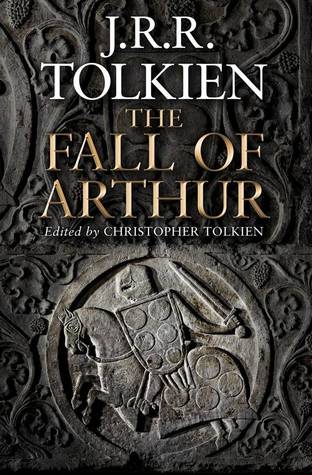The Fall of Arthur
- By J.R.R. Tolkien; edited by Christopher Tolkien
- Houghton Mifflin Harcourt
- 240 pp.
- Reviewed by Hilary Dorsch Wong
- September 26, 2013
Displaying lyrical elegance, the famed author's only Arthurian effort is the latest work compiled and edited by his son.

In the 1930s, before he wrote The Hobbit and Lord of the Rings, J.R.R. Tolkien, professor of English at Oxford University, began crafting an epic about the demise of King Arthur. An alliterative poem in the metrical style of “Beowulf,” this narrative work was Tolkien’s first and only foray into Arthurian legend. Yet, despite extensive work, he never finished it.
Now, the completed portion has been published as The Fall of Arthur. It’s the latest posthumous work by J.R.R. Tolkien that his son Christopher has compiled, edited and published (others include The Silmarillion, The Book of Lost Tales, The Children of Hurin, and the volumes of The History of Middle Earth). After presenting the text of the poem, Christopher places it in the context of Arthurian legend and his father’s canon, and speculates on how the poem might have ended had his father finished it.
The poem is accessible, with a driving plot and engaging use of language. It chronicles the events leading to Arthur’s death, in which his final campaign against the Anglo-Saxons is interrupted by his nephew Mordred’s treasonous attempt to claim the throne, forcing Arthur to return and fight. In Arthur’s absence, Mordred makes sordid advances on Queen Guinevere (here named Guinever), who flees to safety. Lancelot, who previously betrayed Arthur by running away with Guinever and who was denied Arthur’s forgiveness even after Guinever’s return, waits in vain for either Guinever or Arthur to summon him for help.
These are strongly fleshed-out characters.While we learn little about Arthur in the poem, Tolkien explores the motivations and personalities of lust-driven Mordred, self-serving Guinever and conflicted Lancelot. The interplay between Mordred and Guinever, and the backstory of Lancelot and Guinever, constitute the heart of the poem. Lancelot’s character and dilemma are particularly compelling:
He his lord
betrayed to love yielding,
and love forsaking lord regained not;
faith was refused him who had faith broken
by leagues of sea from love sundered.
Tolkien uses the meter of poetry from Norse epics known as alliterative verse to tell the story. The language is almost musical, and favors being read aloud, in lines such as these:
Wolves
were howling on the wood’s border;
the windy trees wailed and trembled
and wandering leaves wild and homeless
drifted dying in the deep hollows.
Christopher Tolkien’s additions, which take up two-thirds of the book, seek to place his father’s work in as complete a context as possible. However, his analysis has narrower appeal than the poem itself, due to its dry and dense style and the insular nature of its content. Fans of Tolkien or of Arthur and those comfortable with Christopher Tolkien’s writing may find more to offer in these sections, but for others, the return on the investment required to read his analysis is questionable.
In his chapter on Arthurian tradition, Christopher Tolkien traces strands of the Arthurian legend that influenced his father, covering Geoffrey of Monmouth, the 14th-century traditions of the “alliterative Morte Arthure” and the “stanzaic Morte Arthur,” and Thomas Mallory’s “Morte d’Arthur” of the 15th century. Fans of Arthurian legend may enjoy learning which specific elements Tolkien borrowed from each tradition, but the breakdown becomes tedious. Christopher Tolkien fails to draw conclusions from this information, or to make wider arguments about Tolkien’s poem from it. As such, it may not engage readers who aren’t already active fans of Arthurian legend.
In his next chapter, Christopher Tolkien takes readers through the unfinished remainder of the poem, presenting how the poem might have continued, based on Tolkien’s notes and drafts. He traces a few elements in those drafts that appear in differing incarnations in The Silmarillion — Tolkien’s text on the creation and early history of Middle Earth— including the Voyage of Eärendil and the Fall of Nứmenor. For instance, in the unfinished part of the poem, Lancelot follows Arthur to “Avallon,” an island from which there is no return, a concept which Christopher tracks to its fruition in Eärendil’s voyage to Valinor in The Silmarillion. Christopher Tolkien assumes readers have at least basic knowledge of The Silmarillion; he makes only the most limited explanation of its stories and characters, potentially obscuring the connection for those not already knowledgeable. This chapter seems directed squarely at Tolkien fans who have read the posthumous works Christopher has edited (he draws no connections with Lord of the Rings or The Hobbit) and it’s unlikely to appeal to the uninitiated. Even as a Tolkien fan, I was put off by this chapter, wanting him to draw more and larger conclusions, rather than simply to draw somewhat tenuous connections and leave them there.
The final chapter, on the evolution of the poem, is perhaps the most challenging to read, a blow-by-blow account of how the story changed over time. It involves lengthy quotes from drafts that in some cases differ from each other only by a word or two. As in the previous chapter, he presents the information but draws few useful conclusions from it.
J.R.R. Tolkien’s name may draw readers to this work, and rightly so. Whether the analysis will appeal to those not already invested in The Silmarillion and Arthurian legend is another question. Christopher Tolkien’s analysis added neither to my appreciation of the poem, nor to my appreciation of J.R.R. Tolkien’s other texts. That may be a function of my own interest in Tolkien, however, and that above all, I love Tolkien’s storytelling. Those who might be deterred by the analysis, but who love Tolkien’s writing, should not be discouraged from picking up the book: the text of the poem, with its wonderful storytelling, remains.
Hilary Dorsch Wong is a librarian and archivist at Cornell University, and a Tolkien enthusiast.

